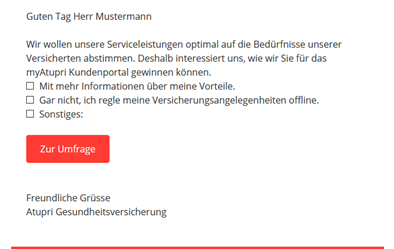Initial situation
When taking out an insurance policy, it is primarily important that the offer fits the personal requirements as well as possible. Other services and self-service offerings, which offer many advantages, initially take a back seat. That is why it makes sense at the beginning of the customer lifecycle to accompany the customer through an onboarding process. In this way, the customer gets to know and use all product-related services in addition to the insurance offers.
The healthcare insurer Atupri offers its customers their own online customer portal and self-service center, where invoices can be viewed, benefit statements submitted and personal insurance details accessed. The aim is to make new customers as well as existing customers aware of the online customer portal and to intensify its use. This also includes the heavily promoted download of a customer portal in app form to benefit from further advantages.
Flow of the use case
Shortly after registration, new customers are welcomed directly to Atupri by e-mail and informed about the advantages of the self-service portal, with the option to register directly. Existing customers, on the other hand, receive an e-mail explaining the advantages of the customer portal. The mailing contains the option to register for the customer portal with just one click. If no click is registered in the e-mail, the customer will receive a reminder after a waiting period. If there is no response, the customer is sent a short survey. The survey serves to find out why insured persons have not registered for the customer portal or how communication can be improved.
Implementation
The strategy was to develop a broad automated marketing process that triggers different communication steps depending on the customer interaction. These bring the customer closer to the customer portal, i.e. the registration process and the various functions, in individual mailings. In this way, increasing customer loyalty can be built up within a very short time – during the most important initial phase in the lifecycle.
Individual query by means of different question types and answer options. Depending on the answer, the customer is forwarded directly to the next appropriate question.

The system automatically checks whether the customer has already started the registration process and assigns the data record to the corresponding step in the automation campaign. The data is fed directly back live into the cycle via an interface. If the customer has already logged into the customer portal once, the automation also checks whether a login has already been made in the app. If not, the customer receives an email (taking into account a certain waiting period) with a brief presentation of the app benefits. This ensures that each customer can be picked up individually and at the appropriate step of the onboarding process.
Two to four additional e-mails are triggered at intervals of one to two weeks, depending on the login status to the customer portal and the app. For example, the campaign automatically informs the customer if the One Time Password (OTP) has expired, the customer has not yet registered for the mobile version, or the login status has not changed. If a customer does not respond after more than two reminders, they are not triggered further and assigned to a defined campaign target. In addition, the mailings provide the customer with information worth knowing about using the customer portal and serve as an aid in the onboarding process. The registration options are only briefly mentioned, visualized with an image and linked to the corresponding landing pages via a CTA.

With such automated campaigns, it is important that a certain waiting period is observed between the individual mailings and that the customer is not overwhelmed by mailings. The prioritization of the mailings and the mailing cadence are controlled by corresponding conditions or via the current status. The emails are sent or triggered after specific actions of the customer (e.g. after the redemption of the OTP, the login in the customer portal or in the myAtupri app).
Technology and results
The result speaks for itself: the directly measurable key figures are far above the defined values. Since the integration of the campaign, the health insurer Atupri has been able to increase registrations in the customer portal by around 10% and attract new myAtupri app users.
The targeted “onboarding” of customers has also demonstrated the desired and sustainable impact of the customer portal. The customer portal is actively used by customers who have gone through the campaign. Mayoris supported and advised the customer in the project from the idea to the final implementation. The operation is carried out on ELAINE, on specially secured servers in each case.
Advantages
- Active support through the onboarding process
- Reduction of customer inquiries thanks to reference to customer portal
- Increase in frequency and active logins to customer portal
- Increase in number of app downloads


